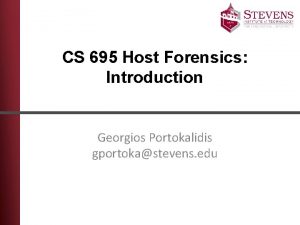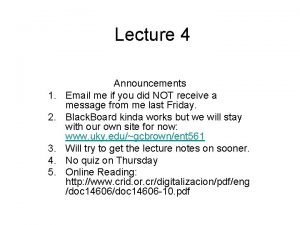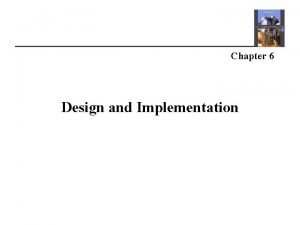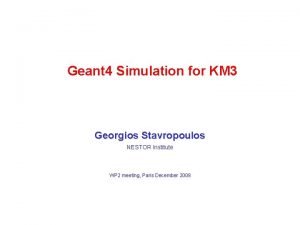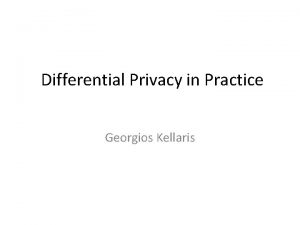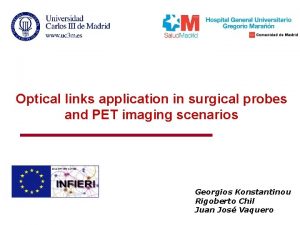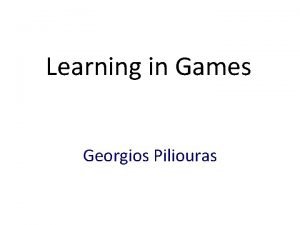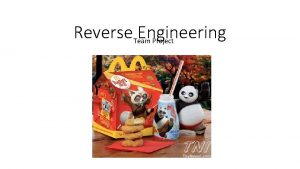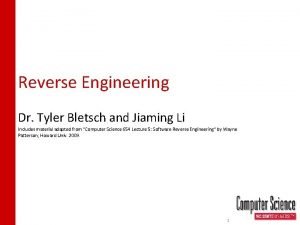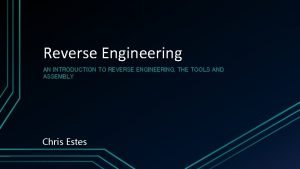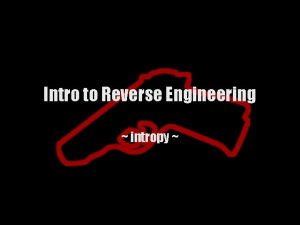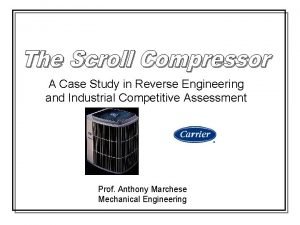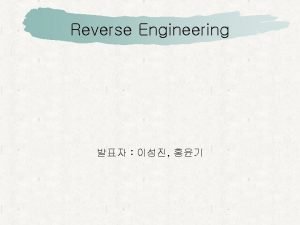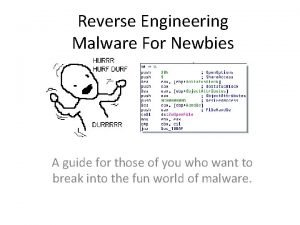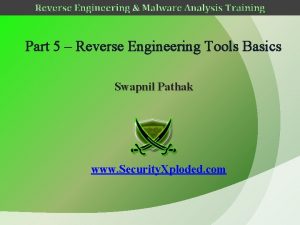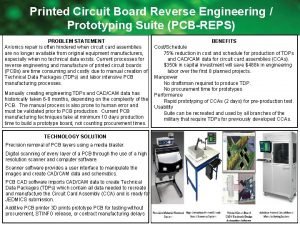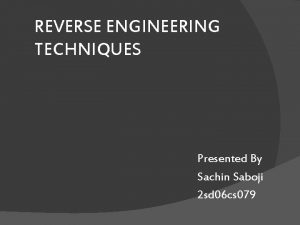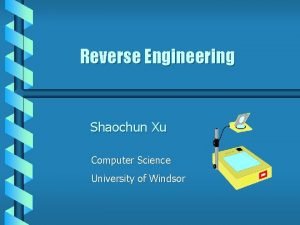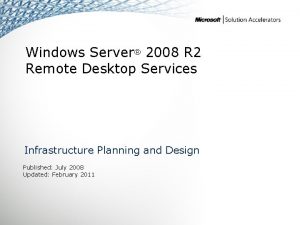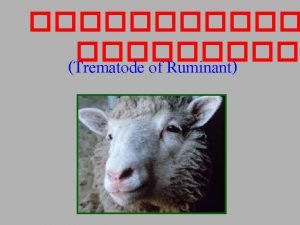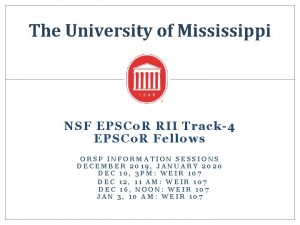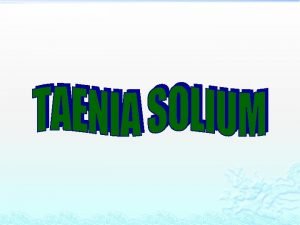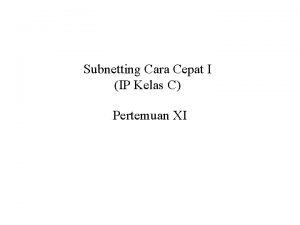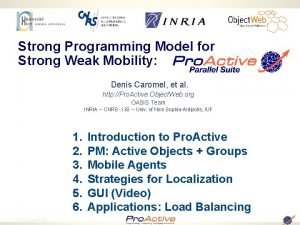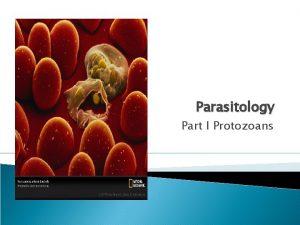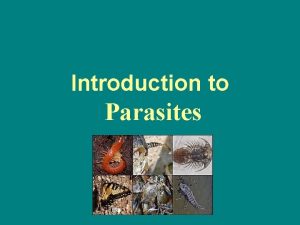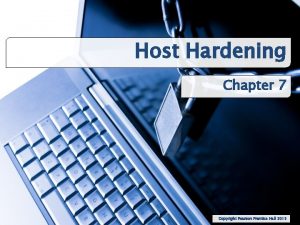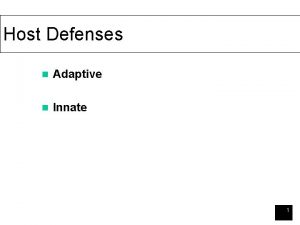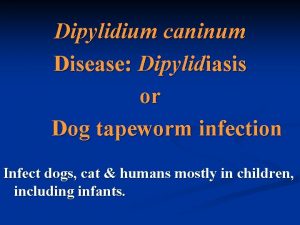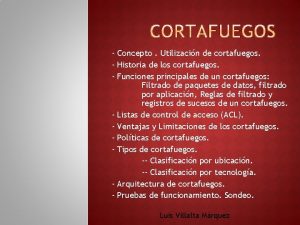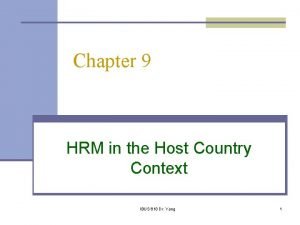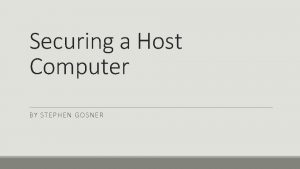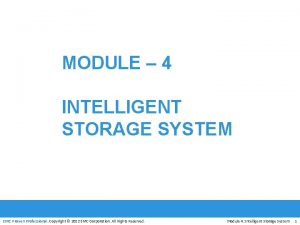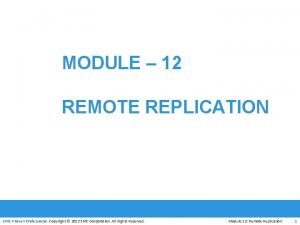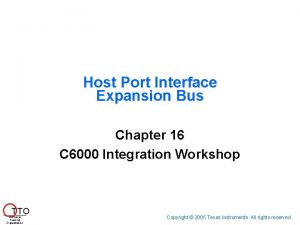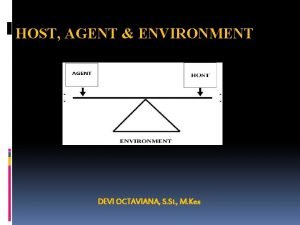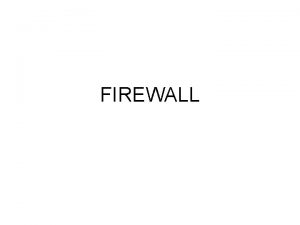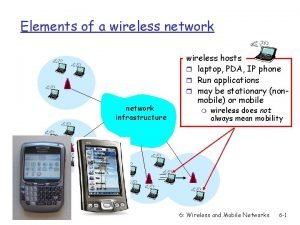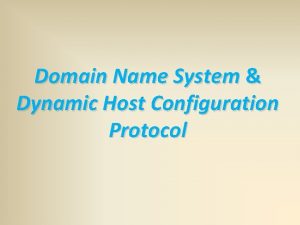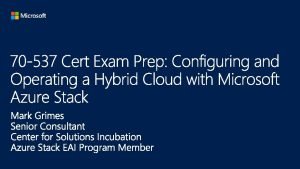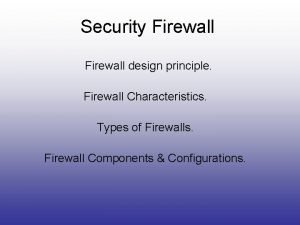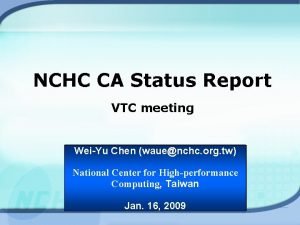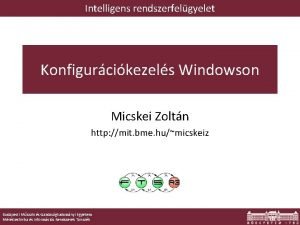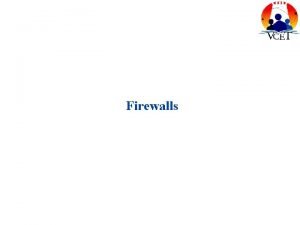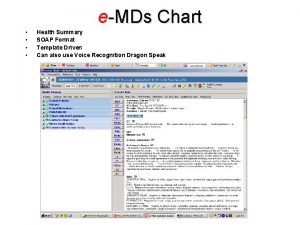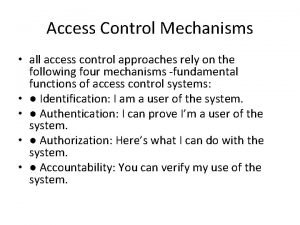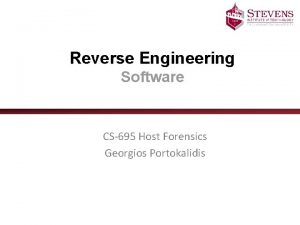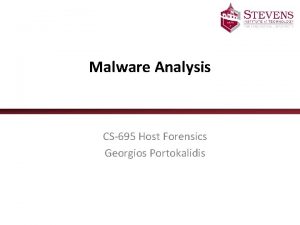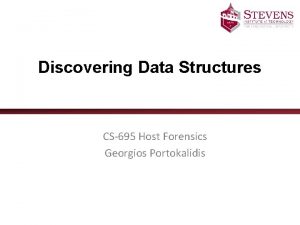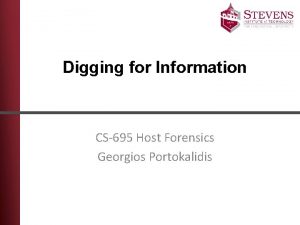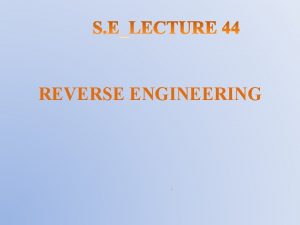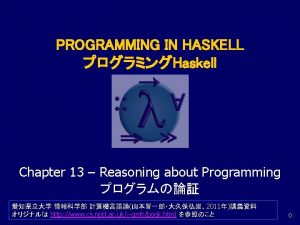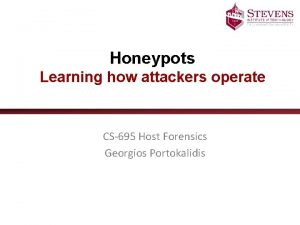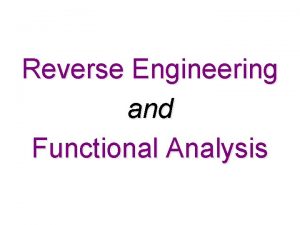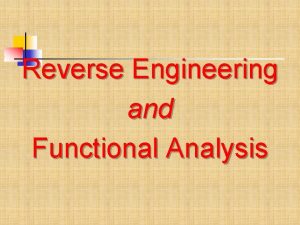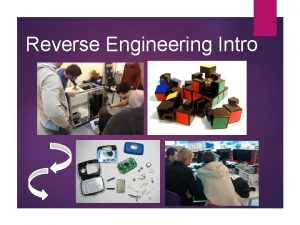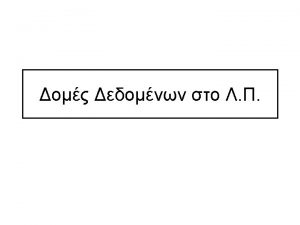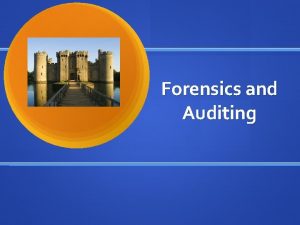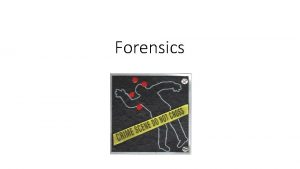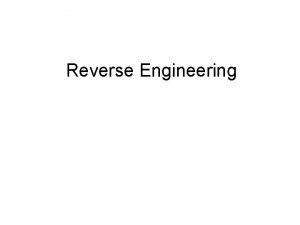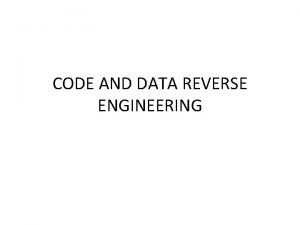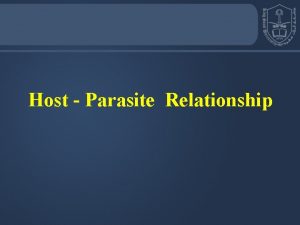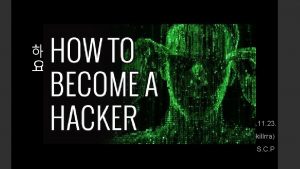Reverse Engineering Software CS695 Host Forensics Georgios Portokalidis
















![ELF Information • elfsh – eresi project [ELF HEADER] [Object /bin/ls, MAGIC 0 x ELF Information • elfsh – eresi project [ELF HEADER] [Object /bin/ls, MAGIC 0 x](https://slidetodoc.com/presentation_image_h2/9029360bbff1b2393dbd6fa4252409a8/image-17.jpg)


























































- Slides: 75

Reverse Engineering Software CS-695 Host Forensics Georgios Portokalidis

Today • Introduction • Static analysis • Dynamic analysis • Challenges 2/236/2013 CS-695 Host Forensics 2

Reverse Engineering INTRODUCTION 2/236/2013 CS-695 Host Forensics 3

2/236/2013 CS-695 Host Forensics 4

In Words • The process of analyzing a system • Understand its structure and functionality • Used in different domains (e. g. , consumer electronics) 2/236/2013 CS-695 Host Forensics 5

Reverse Engineering Software • Understand architecture (from source code) • Extract source code (from binary representation) • Change code functionality (of proprietary program) • Understand message exchange (of proprietary protocol) 2/236/2013 CS-695 Host Forensics 6

Software Engineering First generation language Machine code 001010001101 010111100010 Assemble Second generation language Assembly mov eax, ebx xor eax, eax Compile Third generation language 2/236/2013 C, Java, … int x; while (x<10){ CS-695 Host Forensics 7

Software Reverse Engineering First generation language Machine code 001010001101 010111100010 Disassemble Second generation language Assembly mov eax, ebx xor eax, eax De-compile Third generation language 2/236/2013 C, Java, … int x; while (x<10){ CS-695 Host Forensics 8

A Hard Problem • Fully-automated disassemble/de-compilation of arbitrary machine-code is theoretically an undecidable problem • Disassembling problems – How to distinguish code (instructions) from data • De-compilation problems – Structure is lost • Data types are lost, names and labels are lost – No one-to-one mapping • Same code can be compiled into different (equivalent) assembler blocks • Assembly block can be the result of different pieces of code 2/236/2013 CS-695 Host Forensics 9

Why? • Software interoperability – Samba (SMB Protocol) – Open. Office (MS Office document formats) • Emulation – Wine (Windows API) – React-OS (Windows OS) • Malware analysis • Program cracking • Compiler validation 2/236/2013 CS-695 Host Forensics 10

Binary Analysis Dynamic analysis 2/236/2013 Static analysis CS-695 Host Forensics 11

Static Analysis Can… • Identify the file type and its characteristics – Architecture, OS, executable format, . . . • Extract strings in binary – Commands, password, protocol keywords, . . . • Identify libraries and imported symbols – Network calls, file system, crypto libraries • Disassemble – Program overview – Finding and understanding important functions • By locating interesting imports, calls, strings, . . . 2/236/2013 CS-695 Host Forensics 12

Dynamic Analysis Can… • Observe runtime memory – Extract code after decryption, find passwords. . . • Trace library/system calls and instructions – Determine the flow of execution – Interaction with OS • Debug running process – Inspect variables, data received by the network, complex algorithms, … • Sniff network data – Find network activities – Understand the protocol 2/236/2013 CS-695 Host Forensics 13

STATIC ANALYSIS 2/236/2013 CS-695 Host Forensics 14

Gathering Basic Information • Get some idea about the binary porto@ubuntu: ~$ file /bin/ls: ELF 32 -bit LSB executable, Intel 80386, version 1 (SYSV), dynamically linked (uses shared libs), for GNU/Linux 2. 6. 24, Build. ID[sha 1]=0 x 274 c 7 a 324 a 48 f 28 c 5 c 5 f 80 cfbbd 9 becec 6 bcebe 5, stripped • Strings porto@ubuntu: ~$ strings /bin/ls|head /lib/ld-linux. so. 2 2 z. L' , cr< libselinux. so. 1 _ITM_deregister. TMClone. Table __gmon_start__ _Jv_Register. Classes 2/236/2013 CS-695 Host Forensics 15

ELF Information • readelf porto@ubuntu: ~$ readelf -h /bin/ls ELF Header: Magic: 7 f 45 4 c 46 01 01 01 00 00 00 Class: ELF 32 Data: 2's complement, little endian Version: 1 (current) OS/ABI: UNIX - System V ABI Version: 0 Type: EXEC (Executable file) Machine: Intel 80386 Version: 0 x 1 Entry point address: 0 x 804 be 68 Start of program headers: 52 (bytes into file) Start of section headers: 107492 (bytes into file) Flags: 0 x 0 Size of this header: 52 (bytes) Size of program headers: 32 (bytes) Number of program headers: 9 Size of section headers: 40 (bytes) Number of section headers: 28 Section header string table index: 27 2/236/2013 CS-695 Host Forensics 16
![ELF Information elfsh eresi project ELF HEADER Object binls MAGIC 0 x ELF Information • elfsh – eresi project [ELF HEADER] [Object /bin/ls, MAGIC 0 x](https://slidetodoc.com/presentation_image_h2/9029360bbff1b2393dbd6fa4252409a8/image-17.jpg)
ELF Information • elfsh – eresi project [ELF HEADER] [Object /bin/ls, MAGIC 0 x 464 C 457 F] Architecture : Object type : Data encoding : PHT foffset : PHT entries number : PHT entry size : Runtime PHT offset : Entry point : {OLD PAX FLAGS = 0 x 0} PAX_PAGEEXEC : PAX_MPROTECT : PAX_RANDEXEC : 2/236/2013 Intel 80386 Executable object Little endian 000052 9 32 1179403657 0 x 0804 BE 68 Disabled Restricted Not randomized ELF Version SHT strtab index SHT foffset SHT entries number SHT entry size ELF header size Fingerprinted OS [? ] : : : : 1 27 0000107508 30 40 52 Linux PAX_EMULTRAMP PAX_RANDMAP PAX_SEGMEXEC : : : Not emulated Randomized Enabled CS-695 Host Forensics 17

Libraries • Easy for dynamically linked programs porto@ubuntu: ~$ ldd /bin/ls linux-gate. so. 1 => (0 xb 76 fa 000) libselinux. so. 1 => /lib/i 386 -linux-gnu/libselinux. so. 1 (0 xb 76 ca 000) librt. so. 1 => /lib/i 386 -linux-gnu/librt. so. 1 (0 xb 76 c 1000) libacl. so. 1 => /lib/i 386 -linux-gnu/libacl. so. 1 (0 xb 76 b 7000) libc. so. 6 => /lib/i 386 -linux-gnu/libc. so. 6 (0 xb 750 d 000) libdl. so. 2 => /lib/i 386 -linux-gnu/libdl. so. 2 (0 xb 7508000) /lib/ld-linux. so. 2 (0 xb 76 fb 000) libpthread. so. 0 => /lib/i 386 -linux-gnu/libpthread. so. 0 (0 xb 74 ed 000) libattr. so. 1 => /lib/i 386 -linux-gnu/libattr. so. 1 (0 xb 74 e 7000) • Difficult for statically linked programs 2/236/2013 CS-695 Host Forensics 18

Inside linux-gate. so. 1 porto@ubuntu: ~$ cat /proc/self/maps|grep vdso b 7 fdd 000 -b 7 fde 000 r-xp 0000 00: 00 0 [vdso]. . . porto@ubuntu: ~$ echo "obase=10; ibase=16; B 7 FDD 000/1000" | bc 753629 porto@ubuntu: ~$ dd if=/proc/self/mem bs=4096 skip=753629 count=1 of=vdso porto@ubuntu: ~$ objdump –d vdso: file format elf 32 -i 386 Disassembly of section. text: fffe 414 <__kernel_vsyscall>: ffffe 414: 51 ffffe 415: 52 ffffe 416: 55 ffffe 417: 89 e 5 ffffe 419: 0 f 34 ffffe 41 b: 90 ffffe 41 c: 90. . . 2/236/2013 push %ecx push %edx push %ebp mov %esp, %ebp sysenter nop CS-695 Host Forensics 19

Used Library Functions • Easy for dynamically linked programs porto@ubuntu: ~$ nm -D /bin/ls |head U abort U acl_extended_file_nofollow U acl_get_entry U acl_get_tag_type U __assert_fail U bindtextdomain 080622 e 0 B __bss_start U calloc U clock_gettime U closedir • Difficult for statically linked programs 2/236/2013 CS-695 Host Forensics 20

Recognizing Libraries in Statically-linked Code • Basic idea – Create a checksum (hash) for bytes in a library function • Problems – Many library functions (some of which are very short) – Variable bytes – due to dynamic linking, load-time patching, linker optimizations • Solution – More complex pattern file – Uses checksums that take into account variable parts – Implemented in IDA Pro as: • Fast Library Identification and Recognition Technology (FLIRT) 2/236/2013 CS-695 Host Forensics 21

Original Source Code (some lines snipped for brevity's sake) offset = fread((char *)workblock. . . do_after_key(); window(1, 1, 80, 25); gotoxy(1, 25); clreol(); printf("A sample of the re. . . if( is_ok() == 2) { enc_string_offset = 0; key_adjust(); } 2/236/2013 CS-695 Host Forensics 22

Program Symbols • Used for debugging and linking • Function names (with start addresses) • Global variables • Use nm to display symbol information • Most symbols can be removed with strip 2/236/2013 CS-695 Host Forensics 23

Function Call Trees or Graphs Which function calls which others? Reveals program structure 2/236/2013 CS-695 Host Forensics 24

Disassembly • The process of translating binary stream into machine instructions • Varying level of difficulty – Depending on ISA (instruction set architecture) • Instructions can have – Fixed length • More efficient to decode for processor • RISC processors (SPARC, MIPS) • Variable length – Use less space for common instructions – CISC processors (Intel x 86) 2/236/2013 CS-695 Host Forensics 25

Fixed vs. Variable Length Instructions • Fixed length instructions – Easy to disassemble – Take each address that is multiple of instruction length as instruction start – Even if code contains data (or junk), all program instructions are found • Variable length instructions – More difficult to disassemble – Start addresses of instructions not known in advance – Different strategies • Linear sweep disassembler • Recursive traversal disassembler – Disassembler can be desynchronized with respect to actual code 2/236/2013 CS-695 Host Forensics 26

X 86 ASSEMBLY 2/236/2013 CS-695 Host Forensics 27

Reading It • Assembler Language – Human-readable form of machine instructions – Must understand the hardware architecture, memory model, and stack • AT&T syntax – – – Mnemonic source(s), destination Standalone numerical constants are prefixed with a $ Hexadecimal numbers start with 0 x Registers are specified with % Preferred by UNIX (objdump, etc. ) • Intel syntax – Mnemonic destination, source(s) – Hexadecimal numbers end with h – Used by IDA Pro 2/236/2013 CS-695 Host Forensics 28

Registers • Local variables of processor • Six 32 -bit general purpose registers – Can be used for calculations, temporary storage of values, … – %eax, %ebx, %ecx, %edx, %esi, %edi • Several 32 -bit special purpose registers – %esp - stack pointer – %ebp - frame pointer – %eip - instruction pointer • EFLAGS: the status register • Segment registers: – – – CS (code), SS (stack), DS (data), ES (extra), FS, GS - Artifact of old 8086 processor 2/236/2013 CS-695 Host Forensics 29

Important Mnemonics (Instructions) • mov data transfer • pop / push stack operations • add / sub arithmetic • cmp / test compare two values and set control flags • je / jne conditional jump depending on control flags (branch) • jmp unconditional jump 2/236/2013 CS-695 Host Forensics 30

ALU Instructions • ADD, SUB, AND, OR, XOR, … • MUL and DIV require specific registers • Shifting takes many forms: – Arithmetic shift right preserves sign – Logic shifting inserts 0 s to front – Rotate can also include carry bit (RCL, RCR) • Shift, rotate and XOR instructions are a tell-tale sign of encryption/decryption 2/236/2013 CS-695 Host Forensics 31

The EFLAGS Register 2/236/2013 CS-695 Host Forensics 32

Frequently Used Flags • The EFLAGS register is – used for control flow decision – set implicit by many operations (arithmetic, logic) • Flags typically used for control flow – CF (carry flag) • Set when operation “carries out” most significant bit – ZF (zero flag) • Set when operation yields zero – SF (signed flag) • Set when operation yields negative result – OF (overflow flag) • Set when operation causes 2’s complement overflow – PF (parity flag) • Set when the number of ones in result of operation is even 2/236/2013 CS-695 Host Forensics 33

How Are Flags Set? • Can be – Implicit, as a side effect of many operations – Explicit, as a result of compare / test operations • Compare cmp b, a [ note the order of operands ] – Computes (a – b) but does not overwrite destination – Sets ZF (if a == b), SF (if a < b) [ and also OF and CF ] • How is a branch operation implemented – Typically, two-step process • First, a compare/test instruction • Followed by the appropriate jump instruction 2/236/2013 CS-695 Host Forensics 34

How Are Flags Used? Instruction Synonym jmp label jmp *operand Jump condition Description 1 1 Direct jump Indirect jump je label jne label jz jnz ZF ~ZF Equal/zero Not equal/zero jg label jge label jle label jnle jnl jnge jng ~(SF ^ OF) & ~ZF (~SF ^ OF) SF ^ OF (SF ^ OF) | ZF greater than (signed) greater or equal (signed) less than (signed) less or equal (signed) ja label jae label jbe label jnbe Jnb jnae jna ~CF & ~ZF ~CF CF CF | ZF above (unsigned) above or equal (unsigned) below or equal (unsigned) js label jns label SF ~SF Negative Non-negative 2/236/2013 CS-695 Host Forensics 35

Memory Addressing • Memory is just a linear (flat) array of memory cells (bytes) – Accessed in different ways (called addressing modes) • Most general fashion – Address: displacement(%base, %index, scale) • Where the result address is displacement + %base + %index*scale • Simplified variants are also possible – Use only displacement direct addressing – Use only single register addressing 2/236/2013 CS-695 Host Forensics 36

Byte Order • Important for multi-byte values (e. g. , four byte long value) • Intel uses little endian ordering – Less significant bytes first – How is 0 x 03020100 represented in memory? • • 2/236/2013 0 x 040 0 x 041 0 x 042 0 x 043 0 1 2 3 CS-695 Host Forensics 37

Stack • Managed using – The stack pointer (%esp) – The frame pointer (%ebp) • Special access commands (push, pop) – Write/read to/from the stack – Implicitly alter %esp • Special control flow commands (call, ret) – Do push/pop and jmp • Common uses – Function arguments – Function return address – Local arguments 2/236/2013 CS-695 Host Forensics 38

Function Calls • CALL addr saves current EIP on stack, changes EIP to addr – addr can be immediate or register • RET pops of top of stack, setting EIP back to the value retrieved from stack • Argument passing performed by the application, calling conventions ensure compatibility – Standard. Malicious C conventionprograms (cdecl): Arguments pushed on stack do not need to right-to-left, adhere toreturn value in EAX, calling function cleans stack (i. e. , removes arguments) such conventions! – Microsoft Win 32 convention (stdcall): Same as standard convention, but called function cleans stack • Register preservation conventions determines who saves a register that needs to be preserved by a function call – Caller-saved registers: registers that can be changed by a called function, saved by the callee – Callee-saved registers: registers that should not be changed by a called function, saved by the called • Stack also used for local variables, allocation performed by changing stack pointer 2/236/2013 CS-695 Host Forensics 39

Stack Frame • Helps debuggers locate local variables, etc. • Top of stack frame is stored in EBP – Old EBP is saved in stack – Part of the function prologue push %ebp mov %esp, %ebp – Matching epilogue leave 2/236/2013 CS-695 Host Forensics 40

Tricks • xor %eax, %eax (alternatively sub) – Sets register to 0 • lea (%eax + %eax * 4), %eax – Multiplication by 5 • movb %ah, %al – Shifting 16 bit to the right by 8 positions 2/236/2013 CS-695 Host Forensics 41

A (Very) Small Assembly Program # no input # returns a status code, you can view it by typing echo $? # %ebx holds the return code. section. data. section. text. globl _start: movl int 2/236/2013 $1, %eax $0, %ebx $0 x 80 # This is the system call for exiting program # This value is returned as status # This interrupt calls the kernel, to execute sys call CS-695 Host Forensics 42

Compiling Assembly • We need to assemble and link the code – This can be done by using the assembler as (or gcc) • Assemble – as exit. s –o exit. o – gcc –c –o exit. s • Link – ld –o exit. o – gcc –nostartfiles –o exit. o 2/236/2013 CS-695 Host Forensics 43

Build a Simple Program • Task: Find the maximum of a list of numbers • First need to figure out the following – – Where will the numbers be stored? How do we find the maximum number? How much storage do we need? Will registers be enough or is memory needed? • Let us designate registers for the task at hand: – %edi holds position in list – %ebx will hold current highest – %eax will hold current element examined 2/236/2013 CS-695 Host Forensics 44

The Algorithm • Check if %eax is zero (i. e. , termination sign) – If yes, exit – If not, increase current position %edi • Load next value in the list to %eax – We need to think about what addressing mode to use here • Compare %eax (current value) with %ebx (highest value so far) – If the current value is higher, replace %ebx • Repeat 2/236/2013 CS-695 Host Forensics 45

Initializing. section. data_items: . long 3, 67, 34, 222, 45, 75, 54, 34, 44, 33, 22, 11, 66, 0. section. text. globl _start: movl 2/236/2013 $0, %edi data_items(, %edi, 4), %eax, %ebx # Reset index #First item is the biggest so far CS-695 Host Forensics 46

The Main Loop start_loop: cmpl $0, %eax je loop_exit incl %edi movl data_items(, %edi, 4), %eax cmpl %ebx, %eax jle start_loop movl %eax, %ebx jmp start_loop_exit: movl $1, %eax int $0 x 80 2/236/2013 # Increment edi # Load the next value # Compare ebx with eax # If it is less, just jump to the beginning # Otherwise, store the new largest number # Remember the exit sys call? It is 1 CS-695 Host Forensics 47

More Assembly. LC 0: if statement . string "A < 0n". LC 1: . string "A >= 0n" main: { cmpl jns int a; if (a < 0) { printf(“A < 0n”); } else { printf(“A >= 0n”); } movl call jmp $0, -4(%ebp) /* compute: a – 0 */. L 2 /* jump, if sign bit not set: a >= 0 */ $. LC 0, (%esp) printf. L 3 movl call $. LC 1, (%esp) printf . L 2: }. L 3: 2/236/2013 CS-695 Host Forensics 48

More Assembly. LC 0: . string "%dn“ while statement main: { int i; i = 0; while(i < 10) { printf("%dn", i); i++; } movl $0, -4(%ebp) cmpl jle jmp $9, -4(%ebp). L 4. L 3 movl call leal incl jmp -4(%ebp), %eax, 4(%esp) $. LC 0, (%esp) printf -4(%ebp), %eax (%eax). L 2: . L 4: } . L 3: leave ret 2/236/2013 CS-695 Host Forensics 49

DISASSEMBLY 2/236/2013 CS-695 Host Forensics 50

Types of Disassembly • Linear sweep disassembler – – Start at beginning of code (. text) section Disassemble one instruction after the other Assume that well-behaved compiler tightly packs instructions objdump -d uses this approach • Recursive traversal disassembler – Aware of control flow – Start at program entry point (e. g. , determined by ELF header) – Disassemble one instruction after the other, until branch or jump is found – Recursively follow both (or single) branch (or jump) targets – Not all code regions can be reached • Indirect calls and jumps use a register to calculate target during run time – For these regions, linear sweep is used – IDA Pro uses this approach 2/236/2013 CS-695 Host Forensics 51

IDA Pro • Recursive decent disassembler • Interactive & Iterative • Scriptable (Python & C-like language) • Used to analyze malware 2/236/2013 CS-695 Host Forensics 52

How to Start • IDA Pro 5. 0 free for 32 -bit Windows • IDA Pro 6. 3 demo for 32 -bit Windows, Linux, or Mac • Save work by dumping to IDC – File Produce File Dump Database to IDC file • Open work by re-opening binary and loading IDC file – File Script File 2/236/2013 CS-695 Host Forensics 53

A First Look • The Disassembly window – Use SPACE to switch between text and graph • Imports and Exports window • Functions resolved by the loader – Binary can still load additional functions! 2/236/2013 CS-695 Host Forensics 54

Data Displays • Strings window – View Open Subviews Strings • Stack view window – Edit Functions Stack variables. . . – or double click the variable 2/236/2013 CS-695 Host Forensics 55

Data Display • The Structures view – May or may not give information – More stuff on detecting data structures in the next lecture – Structure types can be assigned to variables • The Enums view – Define constants 2/236/2013 CS-695 Host Forensics 56

Navigation • You can double click on almost everything – Arrows in graph view – Addresses, symbols, variables, . . . – Go back by pressing ESC, the back button, or through the Jump menu • Use Xrefs to find code and data references – Who calls this function? • Jump List cross references to – Who uses this data? • Jump List cross references to 2/236/2013 CS-695 Host Forensics 57

Interaction: Naming • Rename variables and functions – Edit Rename (N) • Assigning type information – Functions • Edit Functions Set type. . . (Y) – Variables • Edit Set type. . . (Y), in stack window • Edit Struct var – Constants • Edit Operand type ► Enum member 2/236/2013 CS-695 Host Forensics 58

Interaction: Editing • Change word width – Edit Data (D) – Useful when defining structs members. – Handy when you mess up the stack with wrong type info! • Make arrays or strings – Edit Array | String • Add comments – Edit Comments Add comments (: ) • Edit anything! – Using the Hex-View 2/236/2013 CS-695 Host Forensics 59

Correcting Disassembly • You can redefine stuff – From code to data, and vice-versa • Edit Code | Data | Undefine • When? – Disassembly gets desynchronized (i. e. , when IDA is wrong) – After deobfuscation/decryption of data (i. e. , data is now code) 2/236/2013 CS-695 Host Forensics 60

More Information https: //www. hex-rays. com 2/236/2013 CS-695 Host Forensics 61

DYNAMIC ANALYSIS 2/236/2013 CS-695 Host Forensics 62

General Information • The proc filesystem – /proc/<pid>/ for a process with pid <pid> – Interesting entries – cmdline (show command line) – environ (show environment) – maps (show memory map) – fd (file descriptor to program image) • File system interaction – lsof – Lists all open files associated with processes 2/236/2013 CS-695 Host Forensics 63

General Information • Windows Registry – Process Monitor (Sysinternals) • Network interaction – Check for open ports • netstat • Processes that listen for requests or that have active connections • Also shows UNIX domain sockets used for IPC – Check for actual network traffic • tcpdump • wireshark 2/236/2013 CS-695 Host Forensics 64

Calls • System calls – Allow user applications to access OS services – Reveal much about a process’ operation – strace • • • Powerful tool that can also Follow child processes Decode more complex system call arguments Show signals Works via the ptrace interface • Library functions – Similar to system calls, but dynamically linked libraries – ltrace 2/236/2013 CS-695 Host Forensics 65

Execute Analyzed Binary • Use a controlled environment – sandbox / debugger • Isolates binary from the rest of the system • Advantages – Can inspect actual program behavior and data values – (At least one) target of indirect jumps (or calls) can be observed • Disadvantages – May accidentally launch attacks – Anti-debugging mechanisms – Not all possible traces can be seen 2/236/2013 CS-695 Host Forensics 66

Debuggers • Common features – Add breakpoints to pause execution • When execution reaches a certain point (address) • When specified memory is access or modified – Examine memory and CPU registers – Modify memory and execution path • Advanced features – – Attach comments to code Data structure and template naming Track high level logic Function fingerprinting • Examples: – gdb for Linux – Ollydbg for Windows 2/236/2013 CS-695 Host Forensics 67

ptrace() • System call for debugging on x 86 Linux • Allows a process (parent) to monitor another process (child) • Whenever the child process receives a signal, the parent is notified – Parent can then • Access and modify memory image (peek and poke commands) • Access and modify registers • Deliver signals • Can also be used for system call monitoring 2/236/2013 CS-695 Host Forensics 68

Breakpoints • Types – Hardware breakpoints – Software breakpoints • Hardware breakpoints – Special debug registers (e. g. , Intel x 86) – Debug registers compared with PC at every instruction • Software breakpoints – Debugger inserts (overwrites) target address with an int 0 x 03 instruction – Interrupt causes signal SIGTRAP to be sent to process – Debugger • Gets control and restores original instruction • Single steps to next instruction • Re-inserts breakpoint 2/236/2013 CS-695 Host Forensics 69

CHALLENGES 2/236/2013 CS-695 Host Forensics 70

A Tough Problem • Reverse engineering is difficult by itself – A lot of data to handle – Low level information – Creative process, experience very valuable – Tools can only help so much • Additional challenges – Compiler code optimization – Code obfuscation – Anti-disassemble techniques – Anti-debugging techniques 2/236/2013 CS-695 Host Forensics 71

Anti-Disassembly • Against static analysis (disassembler) • Confusion attack – Targets linear sweep disassembler – Insert data (or junk) between instructions and – Let control flow jump over this garbage – Disassembler gets desynchronized with true instructions jmp Label 1. short 0 x 4711 Label 1: 2/236/2013 8048000: 74 02 8048002: 47 8048003: 11 90 90 90 8048004: CS-695 Host Forensics je 8048004 inc %edi adc %edx, 0 x 9090(%eax) <Label 1> 72

Anti-Assembly • Advanced confusion attack – Targets recursive traversal disassembler – Replace direct jumps (calls) by indirect ones (branch functions) – Force disassembler to revert to linear sweep, then use previous attack 2/236/2013 CS-695 Host Forensics 73

Anti-Debugging • Detect tracing – A process can be traced only once if (ptrace(PTRACE_TRACEME, 0, 1, 0) < 0) exit(1); • Detect breakpoints – Look for int 0 x 03 instructions if ((*(unsigned *)((unsigned)<addr>+3) & 0 xff)==0 xcc) exit(1); • Checksum the code if (checksum(text_segment) != valid_checksum) exit(1); 2/236/2013 CS-695 Host Forensics 74

2/236/2013 CS-695 Host Forensics 75
 Georgios portokalidis
Georgios portokalidis Definitive host vs intermediate host
Definitive host vs intermediate host Host target development in software engineering
Host target development in software engineering Forward engineering in software engineering
Forward engineering in software engineering Reverse engineering vs forward engineering
Reverse engineering vs forward engineering Georgios margetidis
Georgios margetidis Georgios stavropoulos
Georgios stavropoulos Georgios kellaris
Georgios kellaris Georgios konstantinou
Georgios konstantinou Georgios piliouras
Georgios piliouras Georgios banos
Georgios banos Georgios amanatidis
Georgios amanatidis What is system design in software engineering
What is system design in software engineering Software maintenance process models ppt
Software maintenance process models ppt Frank maurer
Frank maurer Metrics computer science
Metrics computer science Software crisis in software engineering
Software crisis in software engineering Software measurement and metrics in software engineering
Software measurement and metrics in software engineering Real time software design in software engineering
Real time software design in software engineering Software design fundamentals in software engineering
Software design fundamentals in software engineering Reverse engineering team
Reverse engineering team Tyler bletsch
Tyler bletsch Structural analysis reverse engineering
Structural analysis reverse engineering What is functional analysis in engineering
What is functional analysis in engineering Introduction to reverse engineering
Introduction to reverse engineering Windows reversing intro
Windows reversing intro Reverse engineering case study
Reverse engineering case study Ollydbg reverse engineering
Ollydbg reverse engineering Reverse engineering guide
Reverse engineering guide Rdg packer detector
Rdg packer detector Circuit board reverse engineering
Circuit board reverse engineering Phases of reverse engineering
Phases of reverse engineering Reverse engineering
Reverse engineering Reverse engineering computer science
Reverse engineering computer science Remote desktop virtualization host role server 2012
Remote desktop virtualization host role server 2012 Fasciolidae
Fasciolidae Toxoplasma intermediate host
Toxoplasma intermediate host Epsco host
Epsco host Taenia solium
Taenia solium Dashboard toastmasters
Dashboard toastmasters Ip kls c
Ip kls c Weak host model
Weak host model Host-ert456
Host-ert456 Parasitism
Parasitism Classification of host
Classification of host Host hardening
Host hardening Host defenses
Host defenses Ancylostoma caninum
Ancylostoma caninum Screened host architecture
Screened host architecture Host country and home country
Host country and home country Vodafone hosting cloud
Vodafone hosting cloud Host definition computer
Host definition computer Host module
Host module Host module
Host module Paratenic host
Paratenic host Agent host
Agent host Expansion bus interface
Expansion bus interface Host agent environment
Host agent environment Firewall adalah
Firewall adalah Which is host element in wireless
Which is host element in wireless Domain host control protocol
Domain host control protocol Phap host site application
Phap host site application Register asdk azure
Register asdk azure Hosteurope pop3
Hosteurope pop3 Host layers
Host layers Dual homed firewall
Dual homed firewall Screened host firewall
Screened host firewall Wei yu taiwan host
Wei yu taiwan host Wmi provider host
Wmi provider host Host nation support guidelines
Host nation support guidelines Hostinireland
Hostinireland Circuit-level gateways
Circuit-level gateways Emds templates
Emds templates Chapter 6 drinking drugs and health
Chapter 6 drinking drugs and health Nonspecific host defense mechanism
Nonspecific host defense mechanism Since the bastion host stands as a sole defender
Since the bastion host stands as a sole defender
